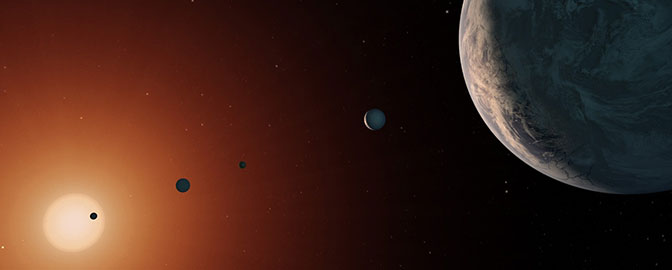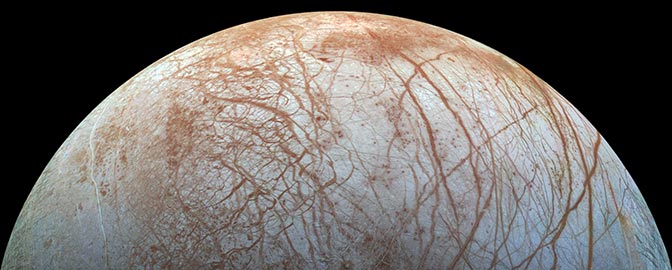Day of Action Deep Prep: Science Mission Directorate
NASA's Science Mission Directorate (SMD) funds and manages the agency's robotic science fleet. It is led by an Associate Administrator, Nikky Fox, who reports directly to the NASA Administrator, and is composed of five distinct divisions, each with their own area of focus:
- Planetary Science
- Astrophysics
- Earth Science
- Heliophysics
- Biological and Physical Sciences
Each division has scientific and missions priorities established by their respective decadal survey, a once-per-decade report prepared by the National Academies of Sciences, Engineering, and Medicine at the direction of NASA and Congress.
Annual budgets for NASA's Science Mission Directorate (SMD), including projections from the FY 2025 budget request. All normalized to 2025 dollars. Inflation adjustments via NASA's New Start Index.
Priority: Restore funding to SMD
The FY 2025 request for NASA's Science Mission Directorate (SMD) is $7.6 billion. This is $231 million more than in 2024 but $226 million below its 2023 amount. Taking into account the effects of inflation, if this proposal goes forward, SMD will have lost over $1 billion of buying power since 2020.
As a consequence, the FY 2025 budget request cancels, defers, or leaves a number of key projects in states of profound uncertainty. This proposal will not enable progress on major priority projects in Heliophysics, Planetary Science, Earth Science, and Astrophysics as recommended by the scientific community.
The Planetary Society and other science organizations believe that SMD must be restored to $9B in 2025. This represents a 4% increase above the 2020 inflation-adjusted level.
The vast majority of science missions are exquisitely designed, one-off projects that are designed to answer specific, high-priority questions in major fields of study. As such, the primary driver of cost is human capital. That is, the highly trained engineers, scientists, and managers that enable such missions. Budget cuts to NASA's science efforts primarily impact individuals, as demonstrated by this year's mass layoffs at JPL. There are no economies of scale to depend on for science missions no no commercial or private sector to rely on to provide similar scientific results. Basic research in space is widely acknowledged as a public responsibility; government must lead the way to advance our fundamental knowledge of the cosmos.
A restoration to $9B allows an "all of the above" approach to NASA's science missions, benefitting projects in every division and enabling a broad coalition within the scientific community. It enables NASA to pursue the top recommendations in each field as determined by their respective decadal surveys.
The Planetary Society, however, is primarily concerned with two divisions: Planetary Science and Astrophysics.
The Planetary Science Division
Planetary exploration is the foundational focus of The Planetary Society. While there are both human and robotic aspects to planetary exploration, the robotic side has seen a far more expansive and extensive program over the history of space exploration. Our focus for human planetary exploration is considered within the Artemis program. Here we will consider robotic, science-driven exploration.
NASA's Planetary Science Division (PSD) is responsible for all robotic missions to destinations in our solar system except for the Sun and Earth. It funds the development and operations of planetary spacecraft, supports the national infrastructure for Plutonium-238 power systems, and is the primary source of research funding for the nation's professional planetary science community. Historically, it has received less than 10% of NASA's total budget.
Though it faced significant budget cuts in the early 2010s, the Planetary Science Division — in part due to the ongoing work by The Planetary Society and its members — has seen its fortunes improve in the past decade.
That changed in 2024, when the division received a $500 million (15%) cut directed at the troubled Mars Sample Return project. The Biden Administration proposed to keep that cut in FY 2025. The Planetary Society wishes to restore this funding.
Despite this, many planetary projects stand to receive solid funding. Dragonfly and NEO Surveyor are supported for 2028 launch dates, VERITAS is restored (though delayed until 2031, along with DAVINCI), commercial lunar payload missions continue at a brisk pace, and funding for fundamental research would increase. However, the start of the next generation of small- and mid-class planetary missions is delayed until 2026 due to the cost growth of both Dragonfly and the two Venus missions.
NASA's planetary science budget, with Biden's FY 2025 proposal. Adjusted for inflation. and normalized 2025 dollars using NASA's New Start Index. Source: Planetary Science Budget Dataset, compiled by Casey Dreier for The Planetary Society (accessible on Google Sheets or downloadable as an Excel file).
There are nine major program areas within the Planetary Science Division:
- Discovery
Competitively selected, small-scale (~$500M each) spaceflight program with a goal of launching a new mission every 2 - 3 years. Current development projects include DAVINCI and VERITAS. - New Frontiers
Competitively selected, mid-scale (~$1 billion each) spaceflight program with a goal of launching once per decade. Current development project is Dragonfly. - Mars Exploration Program
This manages all existing Mars spacecraft and funds Mars-related technology and scientific research efforts. There are no projects in active development. - Mars Sample Return
Due to the prominence of MSR, this project was elevated to its own high-level program that reports directly to upper-level NASA management. At the conclusion of the MSR project, this program will end. - Lunar Discovery and Exploration
The scientific part of the Artemis effort. Includes the Commercial Lunar Payload Services program and upcoming VIPER mission. - Outer Planets and Ocean Worlds
Currently developing the Europa Clipper spacecraft and related technology development for exploring the ice-moons of the outer solar system. - Planetary Defense
Funds ground-based NEO observations and is developing the NEO Surveyor asteroid-hunting spacecraft. - Radioisotope Power
Funds the production of Plutonium-238 and related components, a critical power source for deep solar system and Mars surface exploration spacecraft (or any destination that can't use solar power). - Planetary Science Research
Funds nearly all research by professional planetary scientists in the U.S.
Priority: Mars Sample Return
Mars Sample Return (MSR) is a complex, multi-mission, multi-agency effort to return samples of the Martian surface to Earth. It was identified as the highest-priority effort in the past decadal survey, and NASA has stated its intent to follow through on those recommendations in the coming decade.
Securing funding to enable a Mars Sample Return program within a balanced science portfolio among our highest priorities
Mars Sample Return (MSR), the top priority of the planetary science community in the coming decade, is of particular concern. It emerged from the 2024 budget battered and bruised, with "no less" than $300 million, a far cry from the previous year's $822 million allocated by Congress. The project did, however, secure budgetary flexibility, and NASA can spend upwards of $949 million if necessary. However, the Planetary Science Division, which accounts for the budget of MSR, was itself cut by nearly $500 million. Exactly how much the project needs in 2024 is to be determined, as it is paused pending the results of an internal review and re-formulation.
This is exceedingly rare, if not outright unique in the history of NASA budget proposals. In the most generous interpretation, the White House's Office of Management and Budget, which approves and controls funding requests to federal agencies, was reluctant to request any funding until NASA announced its path forward for MSR, despite clear support for the value of the project and NASA's science portfolio writ large in the FY 2024 appropriations report.
This is not entirely unreasonable. However, the Planetary Science budget remains frozen at $2.7 billion in this proposal, $500 million less than it received in 2023 when MSR was funded at $822 million. NASA leadership has stated that any restart of Mars Sample Return in 2025 will not augur an increase to the Planetary Science Division's budget. And while there appears to be $200 million tucked away in the planetary division's Outer Planets account, seemingly reserved for MSR's restart, that is far from enough to pursue even a leaner and lower-cost sample return effort. Any additional funding for MSR will be cannibalized from other projects.
This is not a supposition. The budget request itself says that due to MSR: "funding levels for Planetary Science missions are subject to change."
The Office of Management and Budget, essentially the White House's accounting office, controls the budget proposal process and has historically been skeptical of large science missions like MSR. The fact that the FY2025 president's budget neglected to request any money for MSR, but went to great lengths to specify alternate budgetary scenarios for other missions — scenarios it itself says are not realistic — will only serve to drive a further wedge between MSR and other planetary priorities. Though the top priority of the current planetary decadal survey, there has been consternation among the scientific community regarding its cost and lack of near-term scientific return, and a persistent worry that MSR might grow so large as to imbalance, disrupt, and delay other important planetary science missions. The Planetary Society, while supportive of MSR, believes strongly in maintaining balance across NASA's science portfolio.
As of April 9th, we are still waiting for NASA to announce the results of its internal review.
Additional reading:
- What's going on with Mars Sample Return?
- The Planetary Society's principles for MSR
- The science value of MSR
Priority: Competed missions
Competed missions are small- and mid-size projects managed by a Principal Scientist that have won a rigorous competition to secure NASA funding. Mission sizes range from $500 million to over $1 billion, and address high-priority science in a more dynamic and directed manner than large flagship missions.
There are currently three competed planetary science missions in development that face various degrees of delay and budgetary threat: Dragonfly to Titan, DAVINCI to the surface of Venus, and the Venus orbiter VERITAS.
The FY 2025 budget request delays DAVINCI and VERITAS to 2031. Dragonfly is targeting a 2028 launch date and receives appropriating funding to enable that schedule.
Additional reading:
Astrophysics
Astrophysics contains five subdivisions grouped by theme:
- Astrophysics Research
provides fundamental research funding and sub-orbital flight opportunities (on balloons and sounding rockets) for astronomers. - Cosmic Origins
Supports projects that address questions such as "how and when did the first stars and galaxies form? ", "when did the universe first create the elements critical for life?", "How do stars and planetary systems form and change over time?" and primarily funds operations for the James Webb and Hubble Space Telescopes. - Physics of the Cosmos
Supports missions that focus on cosmology, high-energy astrophysics, and fundamental physics projects that address central questions about the nature of complex astrophysical phenomena, such as black holes, neutron stars, dark matter and dark energy, cosmic microwave background, and gravitational waves. Major missions include the Chandra X-Ray observatory and NASA's contributions to the European LISA mission. - Exoplanet Exploration
This supports projects that search for planets around other stars. The upcoming Nancy Grace Roman Space Telescope is funded under this subdivision, as is the Habitable Worlds Observatory — the top priority flagship project under the current decadal survey. - Astrophysics Explorer
Provides frequent, competed flight opportunities for small, streamlined space telescopes that are responsive to new knowledge and technology.
Of these projects, The Planetary Society is primarily focused on the Habitable Worlds Observatory, a "super Hubble" class space telescope proposed under the current Astrophysics decadal survey.
Priority: Habitable Worlds Observatory
The HWO will be designed to directly analyze dozens of Earth-sized planets in the habitable zone, providing an excellent opportunity to gain statistically relevant analysis of potential biosignatures in the galaxy.
This is a major undertaking, and, as currently outlined, HWO has funding to prove out a number of critical technologies necessary to its operation. At the start of the 2030s, NASA will make a decision to pursue this mission (or not) based on the success of this technology program.
In 2024, the Habitable Worlds program office was established at NASA Goddard, and modest funding was provided by Congress to begin this project. The FY 2025 budget request proposes $50 million to continue this effort, which The Planetary Society supports.
Additional reading:
Goals for the reader
To understand the scope, major program elements, and upcoming projects within NASA's science exploration efforts
To identify The Planetary Society's top priorities for SMD projects in the next year
To be able to convey the importance of funding Mars Sample Return in a timely manner, and to connect it with near-term legislative action
To understand how programmatic priorities are determined in NASA's science divisions


 Explore Worlds
Explore Worlds Find Life
Find Life Defend Earth
Defend Earth


